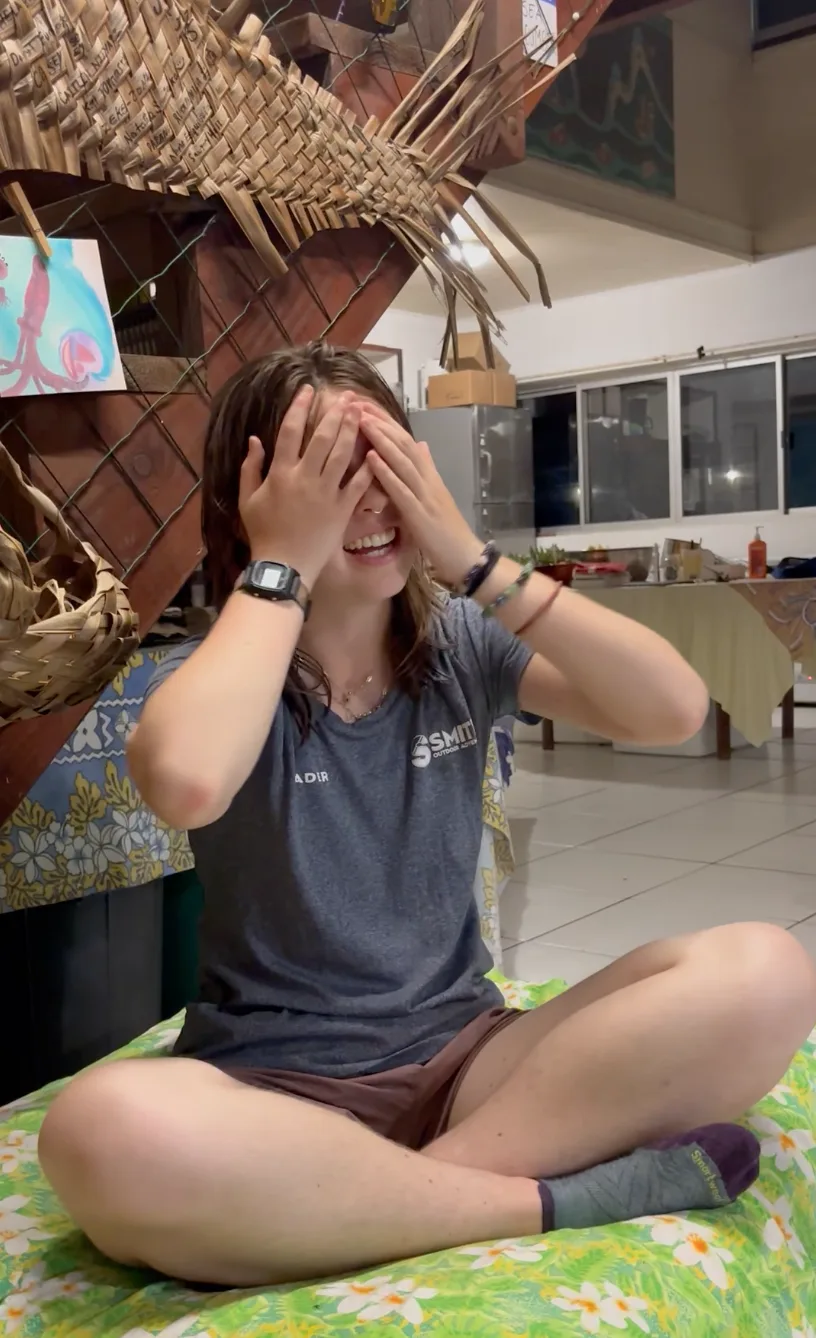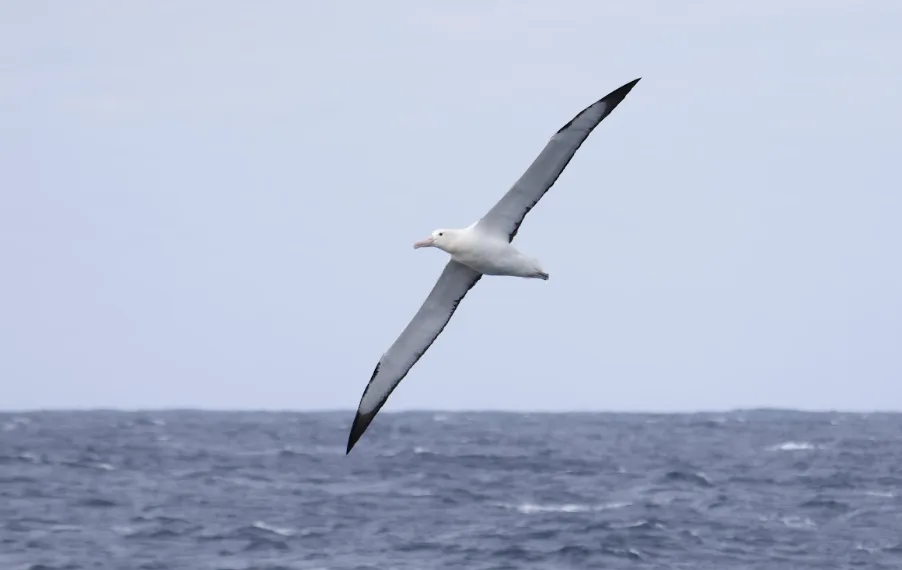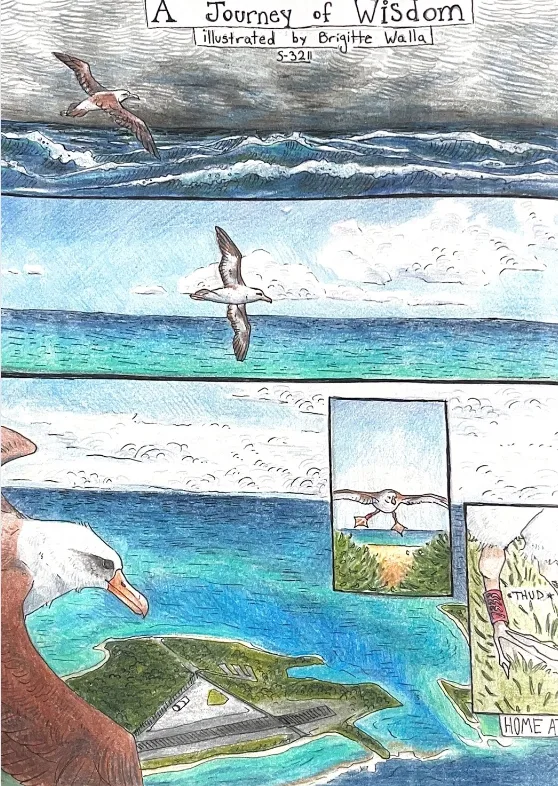Programs Blog
Brigitte On the Atitia Center and Albatrosses

Date: May 28, 2025
Time: 0700
Location: Gump Marine Station, Mo‘orea
Weather: 75˚ F, 5 kts easterly
The following is an excerpt from an interview with Brigitte Walla, Gump Marine Station
This morning in Mo‘orea, in addition to hearing from our host Terava about the founding and mission of the Atitia Center, what did we do there?
We were walked through a few activities with some volunteers who also work there, such as making a star out of palm fronds (chosen because we are sailors) and also learned some different dyes that they use from plants. We got to actually process the dyes out of these plants picked right from the trees and bushes growing out of the ground, where they come from. We also got to help weed a plot where kids are going to plant kumara for gardening. We learned how kids from all over French Polynesia come to this center to learn culture and a little bit of Tahitian, because a lot of them still don’t speak it really well. Information about their own islands is not incorporated in their own education system, which is run by the French government. It was a really, really special morning, and it was special to learn that from people who have put so much work into setting this up in their own community. It was a privilege to learn that.
Could you tell us a sea story?
Hmm, well, I wrote about this in my blog post, but a lot of my trip was defined by a twenty-foot wave that came over the rail and swept me off my feet. I sprained my ankle pretty badly, and we had to go to the Chatham Islands to get it x-rayed. That was all pretty crazy, it is important to the background of the story, but it isn’t the story. While I was at the Chatham Islands, I basically thought I was going to have to leave. I had convinced myself that my foot was really broken. When we found out it wasn’t broken, and I could come back, I was already like I am so excited to be back on the boat, but I knew it was still going to be really hard.
The next day I was awoken to Zach by my bunk. I was actually sleeping on my mattress on the floor because I couldn’t climb up to my bunk. This entire trip, the number one thing I had wanted to see was albatrosses. We had seen some smaller ones, but no big wandering albatrosses yet. When I thought I was going to have to leave, I was thinking that I hadn’t been able to see one. Oh my gosh, I can’t believe I’m going to have to leave before I see the one bird—probably one of the only times in my life I’m going to have this chance to see this bird. I know it’s a funny thing to think about, but it was so stressing me out.
So I woke up that morning to Zach, way before I was supposed to be on watch, saying, “Brigitte, I know you’re not supposed to be awake right now, but there are like twenty albatrosses outside!”
“What?!” I have a boot on at this point, but I don’t know how to use it. I run up to the deck as fast as I can, which is so slow. There are albatrosses literally everywhere. It was crazy! It made me feel in a way, I’m supposed to be here. I was in the right place. Things worked out. This is why I’m here. This is why I’m doing this. It was a sign that I was meant to go on this trip. I had to see the albatrosses, so the universe had me staying.
How has your thinking about marine science and conservation changed over the semester?
You learn a lot (in school) about the open ocean as an abstract concept. And you think, Well, that would be cool to study, but how would you ever get there? You can’t really conceptualize it unless you’re actually there. Being able to see what a pelagic ecosystem actually was, especially so offshore, was really special. It shaped my understanding of how interconnected are these systems and how important the open ocean is to coastal systems.
I really appreciative having the resources to go and see farther offshore, to see the animals that migrate through these big spaces and cross the borders of these big mpas (marine protected areas). These animals are passing through all of these jurisdictions that are managed differently. And we were one of those creatures.
p.s. Our MBC Student Symposium is this Thursday, May 29: 0915 – 1215 Mo’orea time (1515 – 1815 EDT) – on zoom for those not here on site.
Register at this link to receive a zoom invite:
https://us06web.zoom.us/webinar/register/WN_d5eQuQFiTGqMwtSJZKInhA
This is the culminating Research Symposium for S321, Marine Biodiversity and Conservation 2025. We journeyed under sail from Lyttelton, Aotearoa, New Zealand to Mo`orea, French Polynesia on the SSV Robert C Seamans. During the six-week journey at sea, students collected physical and chemical oceanographic data and measured zooplankton biodiversity via morphological and molecular methods. Please join us as each research group reports from the UC Berkeley Gump Station on Mo`orea; the results of their at-sea research will encompass Portuguese man o’ war phylogenomics, myctophid fish biodiversity and population genomics, DNA metabarcoding assessment of biodiversity patterns in copepods, siphonophores, and marine calcifiers.


Recent Posts from the Ships
- Ocean Classroom 2024-A collaborative high school program with Proctor Academy
- Collaborations and Long-term Commitments: SEA’s Caribbean Reef Program Sets a Course for Coastal Programs that Compliment Shipboard Experiences.
- Sea Education Association students prepare for life underway using state of the art nautical simulation from Wartsila Corporation.
- SEA Writer 2022, Magazines From the Summer SEA Quest Students
- Technology@SEA: Upgrades Allow Insight into Ocean Depths
Programs
- Gap Year
- Ocean Exploration
- High School
- Science at SEA
- SEA Expedition
- SEAScape
- Pre-College
- Proctor Ocean Classroom
- Protecting the Phoenix Islands
- SPICE
- Stanford@SEA
- Undergraduate
- Climate and Society
- Climate Change and Coastal Resilience
- Coral Reef Conservation
- Marine Biodiversity and Conservation
- MBL
- Ocean Exploration: Plastics
- Ocean Policy: Marine Protected Areas
- Oceans and Climate
- Pacific Reef Expedition
- The Global Ocean: Hawai'i
- The Global Ocean: New Zealand